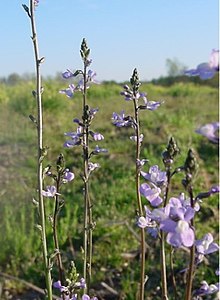
Antirrhinum is a genus of plants in the Plantaginaceae family, commonly known as dragon flowers or snapdragons because of the flowers' fancied resemblance to the face of a dragon that opens and closes its mouth when laterally squeezed. They are also sometimes called toadflax or dog flower. They are native to rocky areas of Europe, the United States, Canada, and North Africa. Antirrhinum species are widely used as ornamental plants in borders and as cut flowers.

Linaria is a genus of almost 200 species of flowering plants, one of several related groups commonly called toadflax. They are annuals and herbaceous perennials, and the largest genus in the Antirrhineae tribe of the plantain family Plantaginaceae.
Toadflax is the common name of several related genera of plants in the family Plantaginaceae, including:
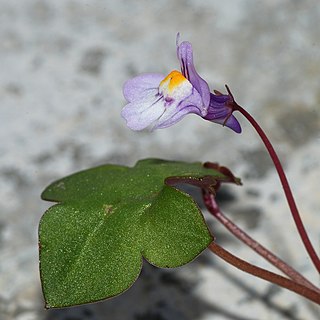
Cymbalaria is a genus of about 10 species of herbaceous perennial plants previously placed in the family Scrophulariaceae, but recently shown by genetic research to be in the much enlarged family Plantaginaceae.

Plantaginaceae, the plantain family, is a large, diverse family of flowering plants in the order Lamiales that includes common flowers such as snapdragon and foxglove. It is unrelated to the banana-like fruit also called "plantain." In older classifications, Plantaginaceae was the only family of the order Plantaginales, but numerous phylogenetic studies, summarized by the Angiosperm Phylogeny Group, have demonstrated that this taxon should be included within Lamiales.

Phrymaceae, also known as the lopseed family, is a small family of flowering plants in the order Lamiales. It has a nearly cosmopolitan distribution, but is concentrated in two centers of diversity, one in Australia, the other in western North America. Members of this family occur in diverse habitats, including deserts, river banks and mountains.

Veronica is the largest genus in the flowering plant family Plantaginaceae, with about 500 species. It was formerly classified in the family Scrophulariaceae. Common names include speedwell, bird's eye, and gypsyweed.

Linaria vulgaris, the common toadflax, yellow toadflax or butter-and-eggs, is a species of flowering plant in the family Plantaginaceae, native to Europe, Siberia and Central Asia. It has also been introduced and is now common in North America.

Linaria alpina, sometimes called alpine toadflax, is a purple-flowered plant native to mountainous areas of southern and central Europe. It belongs to the family Plantaginaceae.
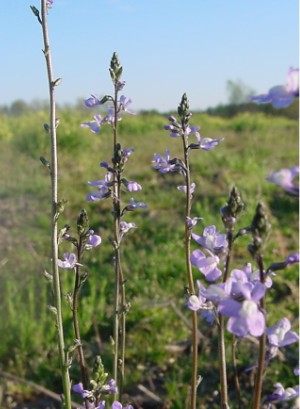
Nuttallanthus canadensis, the blue toadflax, Canada toadflax, or old-field toadflax, is a species of Nuttallanthus in the family Plantaginaceae, native to eastern North America from Ontario east to Nova Scotia and south to Texas and Florida.

Cymbalaria muralis, commonly called ivy-leaved toadflax, is a low, spreading, trailing plant with small purple flowers, native to rocky habitats in southern Europe. It belongs to the plantain family (Plantaginaceae), and is introduced and naturalised in many other temperate locations. The flower stalk is unusual for seeking light until it is fertilized, after which it grows away from the light. Other names include coliseum ivy, Kenilworth ivy, mother of thousands, Oxford ivy, and wandering sailor.
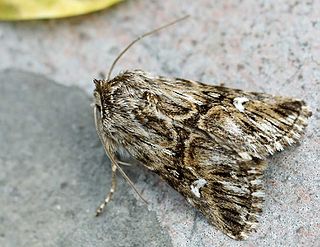
Calophasia lunula is a Palearctic species of noctuid moth known by the common names toadflax moth and toadflax brocade moth.

Linaria purpurea or purple toadflax is a purple-flowered plant native to Italy, part of the plantain family (Plantaginaceae). It is sometimes planted in gardens and is also an introduced weed in North America and other parts of Europe.

Linaria dalmatica is a herbaceous, short-lived perennial plant native to western Asia and southeastern Europe that has become a weed in other areas. The family this plant now belongs to is the Plantaginaceae Family. Previously, it belonged to the Scrophulariaceae (Figwort) family. Its common names include Balkan toadflax, broadleaf toadflax, and Dalmatian toadflax. Linaria dalmatica has unique yellow flowers with an orange center that draw individuals to purchase them to display in their gardens. The distribution of L. dalmatica to North America can be attributed to use as a fabric dye, folk remedies and as an ornamental plant. However, it is now classified as a weed in both Canada and the U.S.

The Antirrhineae are one of the 12 tribes of the family Plantaginaceae. It contains the toadflax relatives, such as snapdragons.
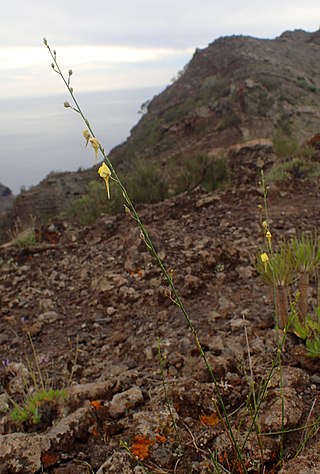
Nanorrhinum scoparium, synonym Kickxia scoparia, is a yellow-flowered plant native to rocky areas of the Canary Islands in the North Atlantic. It belongs to the plantain family (Plantaginaceae).

Linaria repens, also known as pale toadflax or creeping toadflax in Europe and as striped toadflax in the US, is an herbaceous plant in the family Plantaginaceae, native to Europe.
Rhinusa pilosa is a species of true weevil in the family of beetles known as Curculionidae. It is found exclusively on Linaria vulgaris Mill. (Plantaginaceae), also known as common or yellow toadflax where it creates a gall on the plant's stem, and was found originally in Serbia. R. pilosa has been introduced in the United States and Canada as an biocontrol agent to control L. vulgaris.
Linaria pseudolaxiflora, the Maltese toadflax, is a species of flowering plant in the family Plantaginaceae. It is native to Malta and the islands of Linosa and Lampedusa. They are listed as vulnerable by IUCN.
Linaria triphylla is a species of plants in the family Plantaginaceae.
